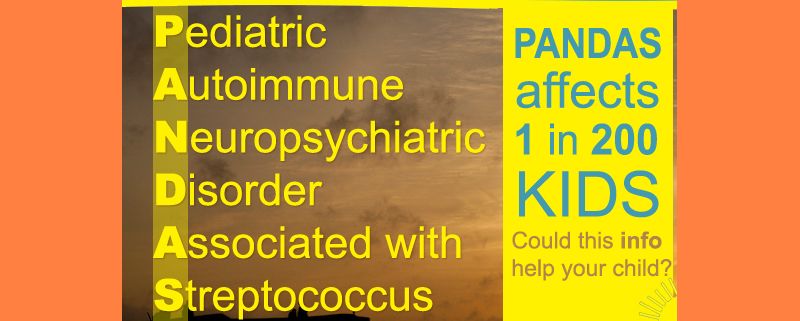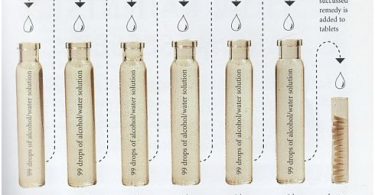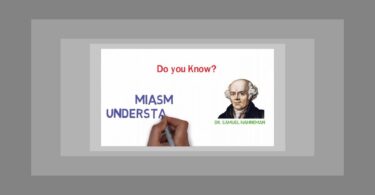Pandas – Paediatric Autoimmune Neuropsychiatric Disorder Associated with Streptococcal infection – is an illness that is becoming more prevalent in modern times. Pandas is a mix of psychological and physical symptoms made worse during times of infection and stress. It is most common in boys aged two to twenty but increasing numbers of girls are also being affected. Symptoms include irrational fears especially of contamination, physical tics, erratic emotional states and obsessive behaviours. The “S” in Pandas (the streptococcus bacteria) is found in many cases and is the reason that antibiotics and anti-inflammatories are the main treatment of conventional medicine. Although this illness may stem from and is generally associated with a bacterial infection, especially during acute episodes (flares), Pandas affects the whole constitution of the patient from the physical state to emotional wellbeing, right through to the ability to learn and interact with others.
A child with Pandas is generally in a state where they are far from reaching their own potential. Sometimes this shortfall is academic, while in other children it may be social or physical. As every year goes by they miss crucial periods of development both social and psychological. They fall behind their peers and sometimes become more isolated and anti-social as time progresses. Some find it hard to make friends while others have difficulties learning and often have to leave conventional education to be home schooled or enter a special school. They miss frequent periods of education due to bouts of acute infections and for many Pandas kids it can seem that each bout of infection leaves them more prone to another shortly after. These episodes are referred to as ‘flares’ and often involve associated episodes of anger, depression and even rage as the infection affects both their body and their brain.
In an attempt to reduce any dietary inflammatory factors, parents often take gluten products and dairy out of the child’s diet as both are known to cause inflammation in sensitive individuals. Often this change of diet results in improvement, especially in the short term, but rarely does it hold the illness at bay for extended periods. At some point symptoms will resume and despite constant adjustments to diet, changing food alone – although extremely helpful – is usually not enough to bring the Pandas child back to full strength.
Homeopathy has a special place in the treatment of Pandas. In combination with a healthy diet based on whole fresh foods, fresh air, quality sleep and exercise, the Pandas child can be brought back to their full potential. All these factors, including homeopathy, have one thing in common; energy. Whole fresh food provides two important factors – a balanced nutritional intake and the release of energy. Whole fresh foods are usually “live” foods and living substances release energy. Exercise allows energy to flow through the body, while moving muscles release stored energy. Fresh air energises the lungs and improves blood flow, while quality sleep rejuvenates and restores via an energetic process that is known to be more complete than just rest alone; yet the process of how all this happens still eludes science. Sleep is amazing in that we spend (or should spend) one third of our life asleep and yet we often don’t give it the place of importance that it deserves. Sleep is another energetic component that is really important to living a healthy life and building the body to withstand disease.
Homeopathy is an energetic medicine, and like the mechanism of sleep, no-one quite knows how or why it works. There are new insights developing as science delves into the inner world of quantum physics but the exact pathway is still unknown. However not knowing how or why something works has never stopped humans from utilising outcomes and Homeopathy is no different. It has a rich and successful 200-year history that has spread worldwide and been embraced from the household to the hospital. Both non-toxic and effective, the correct use of homeopathy can be a turning point on the road to healing for the Pandas child.
There are three ways to approach illness or any health problem.
- Replenishment
- Repulsion
- Destruction
Replenishment (which is a form of resistance) is where a patient is nurtured and ‘re-built’ to become the strongest form of themselves. An outcome of rebuilding is that the host becomes strong enough to deal with stresses in the environment including unwelcome bacteria. During treatment the inherent personality and character remains unchanged but the patient become their best self.
Repulsion is where the problem or stress (eg the bacteria) is targeted for removal. It is encouraged to leave through various means. When using homeopathy in this way the energy of the remedy is matched to the energy of the invader and a ‘repulsion’ occurs. Similar to placing the ends of a magnet to the same ends of another magnet, the two forces repel one another. This approach has been used through-out homeopathy’s history to remove acute contagious illnesses of both viral and bacterial origin.
Destruction is usually the third approach once the other two methods have failed. When an invading virus, parasite or bacteria is taking over the host, and the host doesn’t have the resources or time to resist or even to repel, this method is employed by conventional medicine. Destruction as a line of attack should always be the last position. Killing bacteria using antibiotics is essential if the patient isn’t responding to the first two approaches, however using a destructive approach on a regular basis will weaken the host and lead to future problems.
Homeopathy does not work in a destructive way but it is an effective way of resisting or repelling through the use of energy. Many homeopaths favour the acute approach when treating Pandas as it is easier to target specific problems and attempt to repel them one by one. However, the Pandas patient rarely builds up the strength needed for future resistance using this methodology alone, and as a result the patient may often only experience momentary periods of relief. This is because Pandas is much more than an acute flare up of symptoms. Even though for some, the origin of Pandas may stem from a single bacterial episode, once the syndrome begins the outcome is far more severe than an acute episode. The reason the patient succumbed so seriously at the time of the original episode, and then continued to be affected so severely, is because their system was not strong enough to repel the bacteria effectively from the beginning. The fact that Pandas symptoms remain after the infection is over shows that the patient’s system is still not strong enough to return back into balance. Repelling or destroying the bacteria by itself is simply not enough.
Pandas is best treated through building up the body. A strong body has an equally strong immune system which is designed to deal naturally and effectively with all types of external stress including bacteria. But don’t be fooled into thinking that the body can build itself back up without support. Weak bodies get sick and will become even sicker if they are not directed towards healthy rebuilding. Nature works perfectly when conditions are optimal but when conditions aren’t as good as they should be, extra support and replenishment are required. Until this optimal stage is reached, sometimes a repelling or a destructive model of medicine is needed to give time. But neither of these models can bring about the sustained strength and health that replenishment (constitutional) homeopathy can provide, especially when combined with whole foods, sleep and exercise.
Homeopathy has further sub-categories (or methodologies) within the replenishment model. This can seem confusing to the patient who doesn’t understand the reason for such different methods. These methods – investigating the mind and the emotions as well as the disease – are just different ways to find a remedy that works at a deep level. Essentially the role of a constitutional homeopathic practitioner is to find an energetic medicine (and sometimes a few in succession) that resonate to the patient. That is, an energy that the body recognises as ‘self’. Self energy is an energy that the body can use immediately to fight infection as well as rebuild and repair.
The only way to find energetic or remedy recognition is through using the concept of totality. Totality means an observation of how the body behaves under stress and how the mind/emotions behave under stress. Since the time of Freud many homeopaths have focused solely on the mind but this is like studying a labyrinth of pathways with no beginning or end – a difficult process and one that some homeopaths prefer to work around and beyond. When dealing with Pandas children time is important; plus the Pandas child has little ability to share their mental state effectively due to their age and the severity of their illness. Fortunately, totality is expressed throughout the body in other ways and especially in how the patient reacts to stress – physically as well as mentally. Another important indicator to finding the right energy is the face.
Since the 1800’s homeopaths have noticed the facial structure of different patients and pondered the relationship between facial structure and illness in a concept homeopaths called The Miasms. Miasms are meant to be the underlying component to understanding all health and illness. There are various ways of looking at this deep and underlying theory but reverting back to the energetic model is the most straightforward and the most clinically useful. The three energetic patterns that drive all universal processes are those of outward motion, inward motion and circular motion. These are the only directions of movement in our three dimensional universe. At a macro level three good examples are the outward energy of the sun, the inward energy of gravity and the circular energy of planetary cycles. Each of us has these same energies inside us but in different proportions. These energies are a blueprint to the way our body functions as well as what we look like. Each homeopathic remedy, like each individual, also has its own energy blueprint. Matching these energies – the blueprint of us to the blueprint of the remedy – allows for an intake of energy via the remedy to commence and maintain the rebuilding process. Examining facial structure within the Homeopathic context is known as Homeopathic Facial Analysis (HFA). This process allows the practitioner to find remedies that resonate with the patient quicker than using the mind or layers of bacterial treatment.
The following is a case example demonstrating how a young boy with Pandas symptoms returns to normal balance within a few months. The patient is only seen briefly via Skype. His mother has filled out a health proforma and sent facial analysis photos prior to the Skype discussion.
Jimmy aged 7 July 2015
Jimmy is booked into the clinic and his proforma details the following:
Tics – commenced 2 months ago – repeated raising of one shoulder and tongue protruding
Anxiety – onset 4 months ago
Other complaints – eczema since an infant – mainly on the torso both chest and back and behind the knees and elbows. The eczema comes and goes between 10/10 at its worst but is usually between 4 and 6/10.
Current treatment – diet with no wheat or dairy, multi vitamins and magnesium – some improvement seen but some days he is as bad as ever
Noise – very sensitive to, including all machines such as the vacuum and lawn mower. This has been worse the last few months.
Inflammation/infection – generally susceptible to ear and eye infections but 6 months ago had a very bad throat with white spots and extreme pain. 2 rounds of antibiotics required but it took 4 weeks to heal.
Nose – always blocked yet he doesn’t get many colds.
Tongue – white or even yellow coating is common.
Speech – occasionally stutters or forgets words.
Digestion – often has a bloated stomach with cramps.
Appetite – usually very large, craves fruit, pork, dairy (doesn’t have now), sweets and bread (doesn’t have now).
Bowels – changeable, from constipated to very loose. Often small balls and diarrhoea.
Muscles – complains of pain after exercise, generally a weak boy without much strength.
Perspiration – very little except occasionally sweaty fee or head. Limbs are often cold.
Sleep – nightmares the last 4 months.
Skin – occasionally cortisone cream but daily topical natural creams and oils to prevent dryness and itching.
General – when he used to cut new teeth he would always get sick.
After his infected throat he developed panic attacks which he had never experienced before. These attacks come on before his soccer lessons and have left him with low confidence and exaggerated fears.
Separation – as an infant he was always a little clingy but once he started pre-school he was fine. Now in his third year at school he has reverted to needing to know his mother is close and questioning if she loves him.
Tics – began a few months ago – when he is tired or stressed he repeatedly shrugs his left shoulder and/or opens his mouth and protrudes his tongue.
He has never been vaccinated and recently his paediatrician diagnosed him with leaky gut – he is taking probiotics and supplements and his mother says they have helped a bit.
OCD – in the last 2 weeks he has become obsessed about where the family dog is. Although his gut is slightly improved his behaviours are still regressing.
Sleep – he is having nightmares most nights – generally about monsters or being separated from his mother. ‘Taken away by bad men’.
Emotions – his behaviour can be erratic – from lacking in emotion to a type of blankness or irritable and negative. He has told his mother he has violent thoughts of hurting others. He has punched his younger brother with force a few times.
Skin – in the summer when he swims and is outside often it almost fully clears but recently it has been quite bad – very itchy and bleeding after he scratches.
Process
The core symptoms are repertorised (a homeopathic process where hundreds of remedies are cross referenced to see which of them presents with a matching symptom picture). Pandas patients (and any patient with any illness treated homeopathically) will only respond to a few of many hundreds of potential remedies. This process is then again cross referenced to Jimmy’s facial structure to target the most effective potential remedies. From this process 10 remedies look suitable for Jimmy.
The structure of Jimmy’s face shows that Jimmy has dominant energy that is circular. This means his defence system will try and combat viruses and other illnesses by ‘capturing’ them with circular energy which means congestion or inflammation will occur in order to stop their progress. A remedy with the same energy pattern will double up on the body’s ability to balance and repair itself. Of the 10 remedies left after the final analysis 3 potentially have the same energy as his body. The first remedy, homeopathic Sepia 30 C is chosen. Jimmy’s mother is instructed to give Jimmy one dose each day until the next follow up. She is also asked to ensure he continues to eat well and gets daily exercise outdoors and plenty of sleep. Jimmy’s mother is already implementing all of these important energy stabilisers so the remedy treatment will be a fundamental factor in Jimmy’s recovery.
2nd follow up August 2015
Since being on the Sepia his tics have virtually stopped. Once during the month, he shrugged his shoulders and poked out his tongue. Prior to the remedy he was ticcing daily. His confidence is returning and he has only had nightmares a few times and was less disturbed by them. He has stopped asking his mother if she loves him and is playing better with his brother. He has had no panic attacks and his teacher reports he is more settled at school. Before soccer he is now excited to go and doesn’t cry anymore or have to be coaxed. Overall his mother says he is 90% better in his Pandas symptoms. His skin is also better – about 80% better.
Instruction – keep taking the Sepia once a day. During the month Jimmy’s mother makes contact as she feels he is slipping back a little. She is advised to increase the dose to twice per day.
3rd follow up September 2015
Two weeks earlier Jimmy had an ear infection and a cold but it cleared within a few days. He is still doing well overall but has developed a clicking sound which he repeats at random. He is also displaying a little anxiety although he has not had any panic attacks. There is a requirement for some reassurance again.
When a patient’s symptoms slip backwards, despite a change in the dose of their remedy, a new remedy is searched for. The new remedy must again match the totality and the internal energy pattern shown by the facial structure of the patient. The next remedy is homeopathic Arnica 30C one dose once daily.
4th follow up October 2015
Sometimes a well indicated remedy doesn’t work as well as first expected, even though on paper it matches the patient and their underlying energy pattern very well. Although Jimmy is still much better than when he first presented there are signs that he is not progressing. These include some night terrors and his skin getting worse again. A third remedy is chosen from his energy group. Homeopathic Apis 30C, one dose once per day.
5th follow up November 2015
The ApIs has worked as effectively as the Sepia and even more so. Jimmy is doing really well again. His moods are normal, the tics are gone, his anxiety is gone (he is sleeping on his own again) there have been no nightmares or night terrors and no aggressive behaviour or violent thoughts. His skin is much improved again and his teacher reports good concentration in the classroom and he has jumped up two levels in his reading.
Instruction – continue the Apis 30C once daily- follow up in 2 months.
Cases like Jimmy’s are frequently successful using this methodology. It is common to trial a few remedies but once a small group of close to ‘self’ remedies are found, treatment can be successful for long periods using only one or two remedies. This type of replenishment (or constitutional) treatment, allows the body to rebuild and rebalance itself. Some patients need to touch base every few months while others will be healthy for much longer periods of time with either a remedy taken on an as required basis, or sometimes a patient will continue to do well taking no remedies at all. However, it is common where stress occurs again for a patient to slip back again but just as easily they can be brought back to full strength and balance with another course of a daily dose HFA constitutional remedy.
————————-
The book: PANDAS – Reaching out, A natural and homeopathic approach, details how naturopath and homeopath Grant Bentley works with the illness and how he builds up health to bring about change. The book highlights how the illness develops, what can be done with diet and exercise, as well as the support of constitutional prescribing. Grant discusses just how much can be expected with case examples. Both compassionate and to the point, this book shows parents that PANDAS is not a life sentence but an opportunity to bring about health and balance using a natural approach.
PANDAS Reaching out – A natural and homeopathic approach
About the Author
Grant Bentley (ND Dip Hom Grad Dip Psych. Th reg AROH, ATMS) has 25 years’ experience in the treatment of chronic illness and is known world-wide for his specialised methodology HFA (Homeopathic Facial Analysis). He is the author of several books including Appearance and Circumstance, Homeopathic Facial Analysis, Soul & Survival and How Aphorism 27 Changed the World. Grant works with children and their parents from many countries to bring about realistic and deep change in the lives of children with PANDAS.







